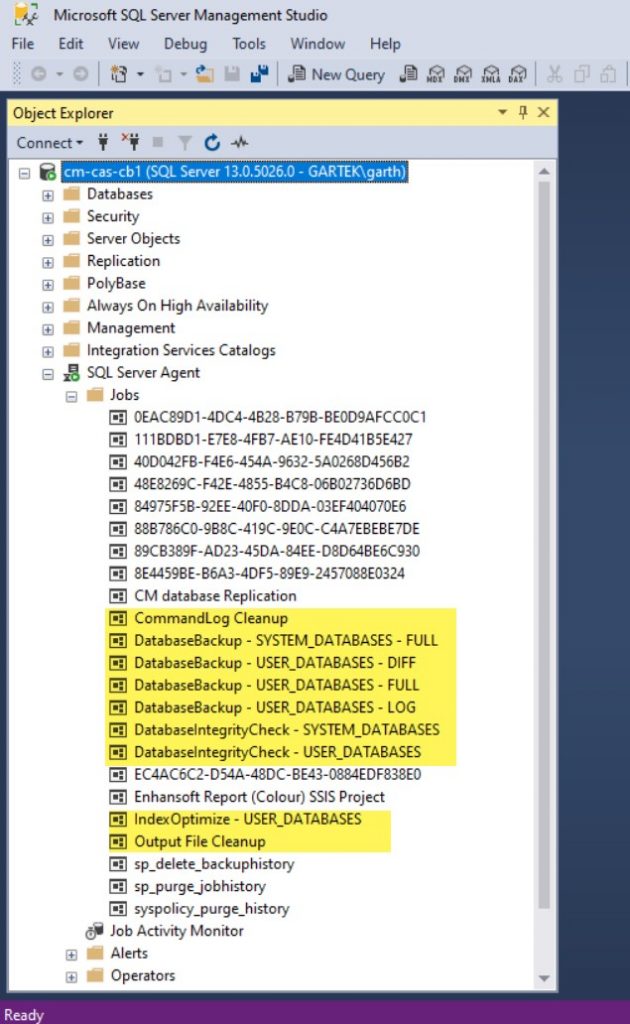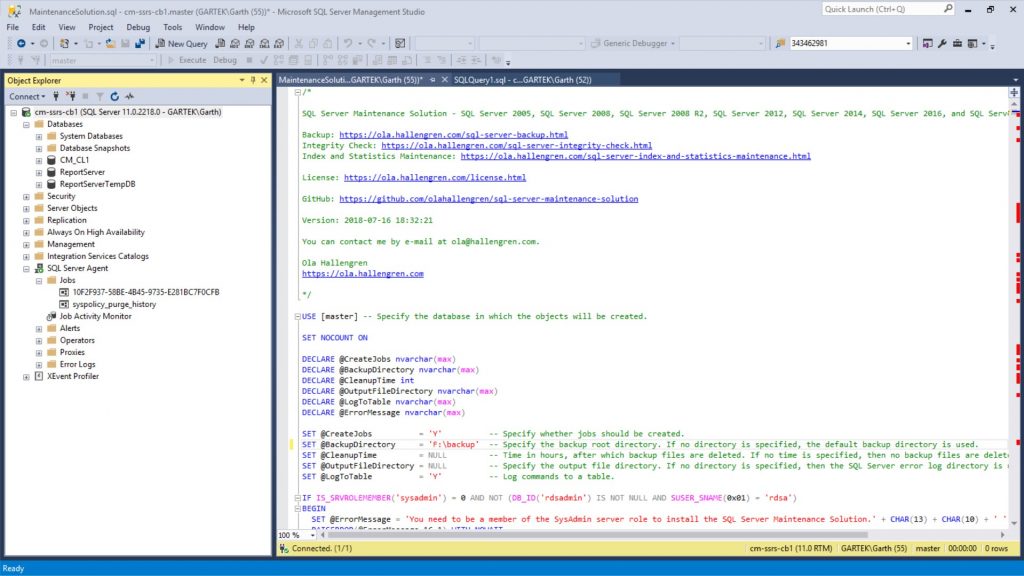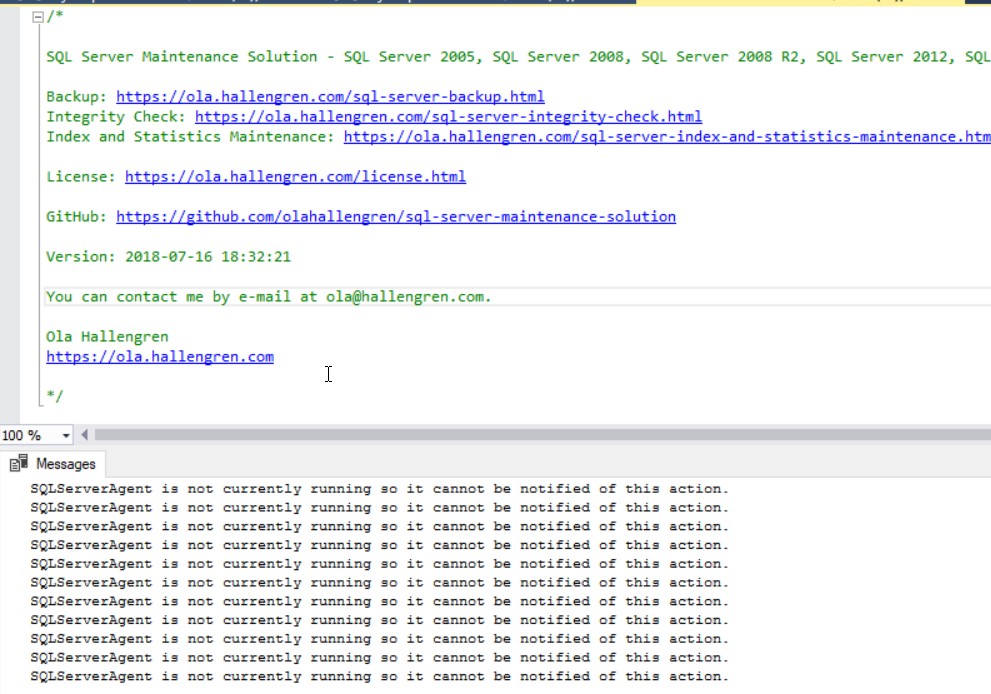Are you tired of countless hours spent troubleshooting and maintaining your SQL Server? Look no further! In this article, we will provide you with a comprehensive collection of SQL Server maintenance scripts that are guaranteed to streamline your operations and ensure the smooth running of your database. These scripts cover a wide range of tasks, from index tuning and database integrity checks to backup and restore operations. Say goodbye to manual intervention and hello to a more efficient SQL Server experience!
Introduction
Welcome to this comprehensive guide on SQL Server maintenance. In this article, we will discuss the importance of regular maintenance for your SQL Server, the benefits of using maintenance scripts, and provide an overview of the key areas that require attention.
Overview of SQL Server Maintenance
Maintaining your SQL Server is crucial for ensuring its optimal performance, data integrity, and availability. SQL Server maintenance involves a set of tasks that address various aspects such as backups, index maintenance, database integrity checks, performance monitoring, disk space management, server and instance configuration, SQL Server Agent jobs, log file cleanup, and adhering to best practices.

Importance of Regular Maintenance
Regular maintenance is essential to keep your SQL Server healthy and running smoothly. By investing time and effort in regular maintenance, you can prevent potential issues, such as data corruption, performance degradation, and unexpected downtime. Regular maintenance helps in identifying and resolving problems at an early stage, ensuring that your SQL Server remains robust and reliable.
Benefits of Using Maintenance Scripts
Using maintenance scripts can significantly simplify and automate the maintenance tasks for your SQL Server. These scripts provide a streamlined approach to perform routine maintenance activities, saving you time and reducing the risk of human error. They offer flexibility, allowing you to customize the scripts according to your specific requirements and system configurations. By leveraging maintenance scripts, you can ensure consistent and efficient execution of maintenance tasks.

Backup Maintenance
Regular backups are crucial for data protection and disaster recovery. SQL Server provides different types of backups that should be performed as part of your backup maintenance strategy.
Full Backups
Full backups capture the entire database, including data, schema, and objects. They serve as a baseline for other backup types and should be performed regularly. Full backups are essential for complete database recovery.
Differential Backups
Differential backups capture the changes made since the last full backup. These backups are faster and smaller than full backups and are useful for reducing backup time and storage requirements. They provide a faster restore option than restoring from a series of transaction log backups.
Transaction Log Backups
Transaction log backups capture the changes made to the database since the last transaction log backup. These backups are critical for point-in-time recovery and maintaining the integrity of your data. Regular transaction log backups prevent data loss in case of a failure.
Backup Integrity Checks
Performing backup integrity checks ensures that your backups are valid and can be restored successfully. Use SQL Server’s backup integrity checks to verify the integrity of your backups and identify any inconsistencies or errors.
Index Maintenance
Proper index maintenance is essential for optimal SQL Server performance. Over time, indexes can become fragmented, leading to decreased query performance. Regular index maintenance tasks can help mitigate these issues.
Index Fragmentation Analysis
Use SQL Server’s built-in tools or third-party solutions to analyze index fragmentation. Identifying fragmented indexes enables you to take appropriate corrective actions such as rebuilding or reorganizing the indexes.
Index Rebuilds
Index rebuilds remove fragmentation and reorganize the index data, leading to improved query performance. Consider rebuilding indexes when fragmentation levels exceed a certain threshold.
Index Reorganization
Index reorganization is a less resource-intensive alternative to index rebuilding. It defragments the index pages and improves query performance. Use index reorganization for moderately fragmented indexes.
Updating Statistics
Statistics provide the SQL Server query optimizer with important information about data distribution in tables and indexes. Regularly updating statistics ensures that the query optimizer chooses the most efficient execution plans. Automate statistics updates to maintain optimal performance.

Database Integrity Checks
Regularly performing integrity checks on your databases helps identify and resolve potential data corruption issues. SQL Server provides various DBCC commands for performing database integrity checks.
DBCC CHECKDB
DBCC CHECKDB is used to check the physical and logical integrity of all objects in a database. It examines the consistency of database pages, indexes, and crucial system catalog tables. Running DBCC CHECKDB periodically helps detect and repair potential corruption issues.
DBCC CHECKALLOC
DBCC CHECKALLOC checks the allocation consistency of the database. It examines the integrity of the allocation structures such as GAM (Global Allocation Map), SGAM (Shared Global Allocation Map), and PFS (Page Free Space). Regularly running DBCC CHECKALLOC ensures the overall integrity of the database’s allocation structures.
DBCC CHECKTABLE
DBCC CHECKTABLE verifies the integrity of a specified table or indexed view within a database. It performs checks on the physical and logical structure of the table, ensuring data consistency. Running DBCC CHECKTABLE periodically helps identify and fix any structural issues within specific tables.
DBCC CHECKCATALOG
DBCC CHECKCATALOG checks the integrity of the sys.sysrowsets and sys.sysallocunits catalog views, which are essential for the functioning of SQL Server. This command helps identify any corruption in the system catalog tables. Regularly running DBCC CHECKCATALOG helps ensure a stable and well-functioning SQL Server instance.
Database Performance Monitoring
Monitoring the performance of your SQL Server is crucial for identifying and resolving performance bottlenecks. Implementing a comprehensive performance monitoring strategy can help optimize your server’s performance.
Identifying Performance Bottlenecks
Use SQL Server’s performance monitoring tools or third-party solutions to identify performance bottlenecks. Analyze metrics such as CPU usage, disk I/O, memory usage, and query performance to pinpoint areas that require optimization.
Monitoring CPU Usage
Monitor CPU usage to ensure that your SQL Server has sufficient processing power to handle the workload. High CPU usage may indicate inefficient queries, resource contention, or hardware limitations. Regularly monitor CPU usage and take necessary actions to optimize performance.
Tracking Disk I/O
Disk I/O performance plays a crucial role in SQL Server performance. Monitor disk I/O metrics such as read/write latency, throughput, and queue length to identify any performance issues related to storage. Optimize disk configurations, consider using solid-state drives (SSDs), and distribute database files across multiple disks to enhance disk I/O performance.
Analyzing Query Performance
Monitor and analyze the performance of your SQL Server queries to identify slow-running or resource-intensive queries. SQL Server provides tools like Query Store and Execution Plans to capture query performance metrics. Optimize poorly performing queries by creating or modifying indexes, rewriting queries, or optimizing query execution plans.

Disk Space Management
Proper management of disk space is crucial for the smooth operation of your SQL Server. Regularly monitor and manage the disk space to ensure adequate storage availability for your databases.
Checking Available Disk Space
Regularly monitor the available disk space on your SQL Server’s drives. Ensure that you have a sufficient amount of free space for database growth, temporary files, and backups. Plan disk space allocation accordingly and take appropriate actions (e.g., adding more storage) if necessary.
Managing Data and Log Files
Monitor the size and growth of the data and log files for your databases. It is essential to prevent auto-growth events, as they can impact performance. Regularly review and adjust the file sizes to avoid excessive growth and fragmentation. Plan file locations and filegroup configurations to ensure efficient disk space utilization.
Shrinking Database Files
Shrinking database files should be done with caution and only when necessary. Shrinking can cause fragmentation and may have performance implications. If there is a significant amount of free space within your database files, consider redistributing data to other filegroups or files instead of shrinking the files.
Server and Instance Configuration
Optimizing server and instance configurations can significantly enhance the performance and reliability of your SQL Server. Perform regular checks and adjustments to ensure an optimal configuration.
Checking Server Configurations
Review the server-level configurations for your SQL Server instance. Ensure that the configurations align with best practices and the requirements of your workload. Check settings such as max server memory, parallelism settings, and tempdb configuration.
Optimizing Memory Settings
Proper memory configuration is essential for SQL Server performance. Adjust the max server memory setting to ensure that SQL Server has sufficient memory allocated, while leaving enough for the operating system and other applications. Monitor memory usage and adjust the configuration as needed.
Configuring Max Degree of Parallelism
Max Degree of Parallelism (MAXDOP) determines the number of processors used for parallel query execution. Configure MAXDOP based on the nature of your workload and the number of processors available. Fine-tuning this setting can prevent resource contention and improve query performance.
Enabling Instant File Initialization
Enabling Instant File Initialization (IFI) can significantly improve performance when creating or expanding database files. It allows SQL Server to skip zero-initialization of the data files, reducing the time taken for these operations. Ensure that the SQL Server service account has the necessary permissions to perform IFI.

SQL Server Agent Jobs
SQL Server Agent jobs provide a means to automate maintenance tasks and schedule them according to your requirements. Leverage SQL Server Agent jobs to streamline your maintenance activities.
Reviewing Existing Jobs
Review the existing SQL Server Agent jobs and identify any gaps or areas that require improvement. Ensure that the jobs are properly configured, scheduled, and have appropriate notifications set up.
Creating Automated Maintenance Plans
Create automated maintenance plans using SQL Server Agent jobs to perform routine maintenance tasks. Customize the plans based on your specific requirements, such as backup schedules, index maintenance, and database integrity checks.
Scheduling Maintenance Tasks
Scheduling maintenance tasks during off-peak hours is crucial to minimize the impact on users and application availability. Consider factors like workload patterns, maintenance requirements, and business constraints when scheduling the SQL Server Agent jobs. Regularly review and adjust the job schedules as needed.
Log File Cleanup
Effective log file management helps maintain a clean and manageable environment. Implement log file cleanup strategies to keep your SQL Server organized and optimized.
Deleting Old Backup History
Regularly delete old backup history to free up space in the msdb system database. Use SQL Server’s built-in maintenance plans or custom scripts to remove outdated backup records. Ensure that any relevant data, necessary for compliance or auditing purposes, is properly backed up or archived before deletion.
Removing Unnecessary Log Files
Remove unnecessary log files that are no longer required for analysis or troubleshooting. Archive and backup the log files as needed before removal. Avoid storing log files on the same drive as the database files to prevent performance degradation.
Archiving and Compressing Logs
Implement a log archiving strategy to store log files for a specified period. Archive logs to a separate location to free up space on the primary drives and ensure faster log file access. Compressing the archived logs can further optimize storage utilization.
Best Practices for SQL Server Maintenance
To ensure the effectiveness of your SQL Server maintenance efforts, consider these best practices:
Regularly Perform Maintenance Tasks
Perform maintenance tasks at regular intervals to ensure the health and performance of your SQL Server. Set up a maintenance schedule that aligns with your organization’s requirements and workload patterns.
Schedule Maintenance During Off-Peak Hours
Schedule maintenance tasks during off-peak hours to minimize the impact on users and maximize system availability. Consider business needs, user activity patterns, and customer expectations when deciding maintenance windows.
Document and Track Maintenance Activities
Maintain a comprehensive log of all maintenance activities performed on your SQL Server. Documenting the date, time, and details of each task helps track progress, identify recurring issues, and demonstrates compliance with maintenance requirements.
Monitor and Analyze Maintenance Job Outcomes
Regularly monitor the outcomes of your maintenance jobs to ensure their successful execution. Analyze logs, monitor alerts, and review performance metrics to identify any anomalies or issues that require attention. Stay proactive in addressing potential problems to maintain a healthy SQL Server environment.
In conclusion, SQL Server maintenance is an essential aspect of managing a reliable and high-performing database environment. By following best practices, using maintenance scripts, and regularly performing tasks such as backups, index maintenance, database integrity checks, performance monitoring, disk space management, server and instance configuration, SQL Server Agent jobs, and log file cleanup, you can ensure the continued success of your SQL Server implementation. Remember, a well-maintained SQL Server leads to improved performance, data integrity, and overall satisfaction for both users and administrators.
Leave a Reply